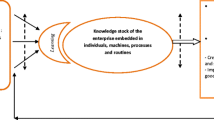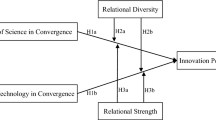Abstract
What makes some firms more innovative than others and what determines the source of these innovations are questions that are still not adequately answered due to the complex, often esoteric, nature of the innovation process. This paper considers the effect of one externally oriented strategy (extent of formal inter-organizational linkages) and one internally oriented strategy (degree of knowledge intensity) on overall levels of innovativeness and the source of these innovations. Using data collected from firms operating in the bioscience-technology industries in both New York and Utah, our results suggest that both of these strategies have a significant effect upon innovation levels and the source of innovation (internally versus externally stimulated). Interestingly, there were few firms that undertook both of these strategies simultaneously and thus the proposed interaction effect where increased absorptive capacity (on the basis of knowledge intensity) would make external linkages even more valuable could not be discerned.
Similar content being viewed by others
References
Alam, I. (2003). Commercial Innovations from Consulting Engineering Firms: An Empirical Exploration of a Novel Source of New Product Ideas. The Journal of Product Innovation Management 20, 300–313.
Arora, A., Fosfuri, A. and Gambardella, A. (2001). Markets for Technology. Cambridge, MA: MIT Press.
Autio, E., Sapienza, H. J. and Almeida, J. G. (2000). Effects of age at entry, knowledge intensity, and limitability on international growth. Academy of Management Journal 43, 909–924.
Brown, S. L. and Eisenhardt, K. M. (1995). ‘Product Development: Past Research, Present Findings, and Future Directions. Academy of Management Review 20, 343–378.
Caloghirou, Y., Kastelli, I. and Tsakanikas, A. (2004). Internal capabilities and external knowledge sources: complements or substitutes for innovative performance? Technovation 24, 29–39.
Chiesa, V. and Toletti, G. (2004). Network of Collaborations for Innovation: The Case of Biotechnology. Technology Analysis & Strategic Management 16, 73–96.
Clark, K. B. and Wheelwright, S. C. (1992). Organizing and leading “heavyweight” development teams. California Management Review 34(3), 9–28.
Cohen, W. M. and Levinthal, D. A. (1990). Absorptive Capacity: A New Perspective on Learning and Innovation. Administrative Science Quarterly 35, 128–152.
Dodgson, M. (1994). Technological Collaboration and Innovation, in M. Dodgson and R. Rothwell (Eds.), The Handbook of Industrial Innovation, Cornwall: Edward Elgar, 285–292.
Eisenhardt, K. M. and Tabrizi, B. N. (1995). Accelerating Adaptive Processes: Product Innovation in the Global Computer Industry. Administrative Science Quarterly 40, 84–110.
Freeman, C. (1991). Networks of innovators: A synthesis of research issues. Research Policy 20, 499–514.
Gambardella, A. (1992). Competitive advantages from in-house scientific research: The US pharmaceutical industry in the 1980s. Research Policy 21, 391–407.
Goes, J. B. and Park, S. H. (1997). Inter-organizational Links and Innovation: The Case of Hospital Services. Academy of Management Journal 40, 673–696.
Grant, R. M. (1996). Towards a Knowledge-based Theory of the Firm. Strategic Management Journal 17(Winter Special Issue), 109–122.
Griliches, Z. (1987). R&D, Patent and Productivity. National Bureau of Economic Research. Chicago: The University of Chicago Press.
Gulati, R. (1995). Social Structure and Alliance Formation Patterns: A Longitudinal Analysis. Administrative Science Quarterly 40, 619–652.
Hamel, G. (1991). Competition for Competence and Inter-partner Learning within International Strategic Alliances. Strategic Management Journal 12, 83–103.
Hauschildt, J. (1992). External Acquisition of Knowledge for Innovations—A Research Agenda. R&D Management 22(2), 105–110.
Herstatt, C. and von Hippel, E. (1992). Developing New Product Concepts via Lead User Method: A Case Study in a “Low-Tech Field”. Journal of Product Innovation Management 9, 213–221.
Josty, P. L. (1990). ‘A Tentative Model of the Innovation Process’, R&D Management 20(1), 35–45.
Kahn, K. B., Franzak, F., Griffin, A., Kohn, S. and Miller, C. W. (2003). Editorial: Identification and Consideration of Emerging Research Question’. Journal of Product Innovation Management 20, 193–210.
Khanna, T., Gulati, R. and Nohria, N. (1998). The Dynamics of Learning Alliances: Competition, Cooperation and Relative Scope. Strategic Management Journal 19, 193–210.
Khurana, A. and Rosenthal, S. R. (1998). Towards Holistic ‘Front Ends’ in New Product Development. Journal of Product Innovation Management 15, 57–74.
Kogut, B. (1988). A Study of the Life Cycle of Joint Ventures, in F. Contractor and R. Lorange (Eds.), Cooperative Strategies in International Business, New York: Lexington Books, 169–185.
McAdam, R. and McClelland, J. (2002). Sources of new product ideas and creativity practices in the UK textile industry. Technovation 22, 113–121.
Mowery, D. C., Oxley, J. E. and Silverman, B. S. (1996). Strategic Alliances and Interfirm Knowledge Transfer. Strategic Management Journal, 17, (Special Winter Issue), 77–91.
Myers, S. and Marquis, D. G. (1969). Successful Industrial Innovation, Washington DC: National Science Foundation.
Nonaka, I. (1994). A Dynamic Theory of Organizational Knowledge Creation. Organization Science 5, 14–37.
Nonaka, I. and Takeushi, H. (1995). The Knowledge-creating Company. Oxford University Press: New York.
Osland, G. and Yaprak, A. (1995) Learning Through Strategic Alliances: Processes and Factors that Enhance Marketing Effectiveness. European Journal of Marketing 29, 52–66.
Quinitas, P., Wield, D. and Massey, D. (1992). Academic-industry links and innovation: questioning the science park model. Technovation, 12, 161–175.
Rothwell, R. (1992). Successful Industrial Innovation: Critical Factors for the 1990’s. R&D Management 22, 221–239.
Shaw, B. (1986). Appropriation and Transfer of Innovation Benefit in the UK Medical Equipment Industry. Technovation, 4,
Shaw, B. (1993). Formal and Informal Networks in the UK Medical Equipment Industry, Technovation, 13, 6,
Sunman, H. (1987). Science Parks, Technopoles and Innovation Centres: The European Experience. Int. J. of Technology Management, 2, 142–145.
Tang, H. K. (1998) An Integrative Model of Innovation in Organizations. Technovation, 18, 297–309.
Teece, D. J. (1989). Innovation and the Organization of Industry. CCC Working Paper 90-6. Centre for Research in Management, University of California at Berkeley.
Ticehurst, G. W. and Veal, A. J. (1999). Business Research Methods: A Managerial Approach, Sydney: Addison Wesley Longman Australia.
Von Hippel, E. (1978). Successful Industrial Products From Customer Ideas. Journal of Marketing 42, 39–49.
Von Hippel, E. (1988). The Sources of Innovation, New York, Oxford, Oxford University Press.
von Krogh, G., Roos, J. and Slocum, K. (1994). An essay on corporate epistemology. Strategic Management Journal 15, 53–71.
Willoughby, K. W. (1997). New York’s Evolving Bioscience Technology Industries: Managing Knowledge, Production and Services for Economic Development. Stony Brook, New York: State University of New York, Center for Biotechnology, 1997.
Willoughby, K. W. (2004). The Affordable Resources strategy and the Milieux Embeddedness strategy as alternative approaches to facilitating innovation in a knowledge-intensive industry. Journal of High Technology Management Research 15, 91–121.
Author information
Authors and Affiliations
Additional information
His interests lay in strategic technology management, intellectual property management, technology-based entrepreneurship, technology-based industry development, and regional economic development planning. Much of his work has focused on life-science related industries. He holds doctoral degrees in both technology studies and strategic management. He also works in the area of technology commercialization education for the U.S. Government’s Federal Laboratory Consortium for Technology Transfer.
He received his PhD from the University of Western Australia in 1998. His present research interests focus upon the nexus of strategy and innovation, and have included studies in the bicycle, financial services, airline and biotechnology industries.
Rights and permissions
About this article
Cite this article
Willoughby, K., Galvin, P. Inter-organizational collaboration, knowledge intensity, and the sources of innovation in the bioscience-technology industries. Know Techn Pol 18, 56–73 (2005). https://doi.org/10.1007/s12130-005-1005-z
Issue Date:
DOI: https://doi.org/10.1007/s12130-005-1005-z




